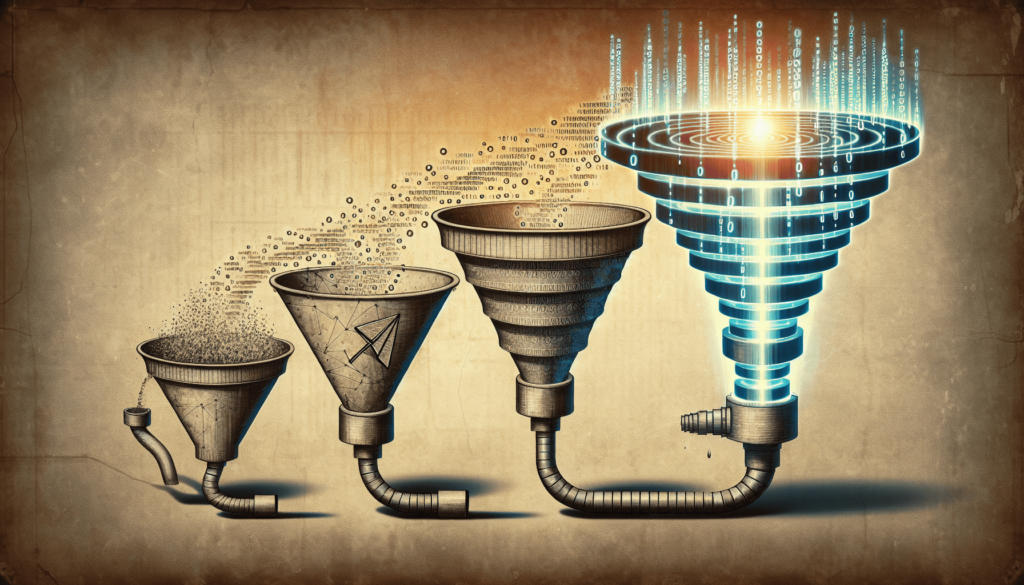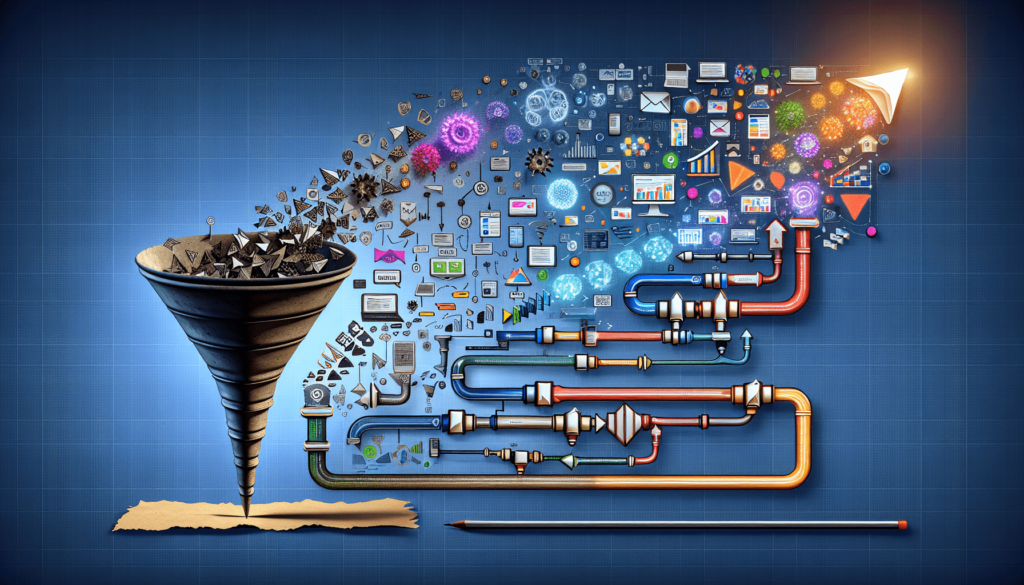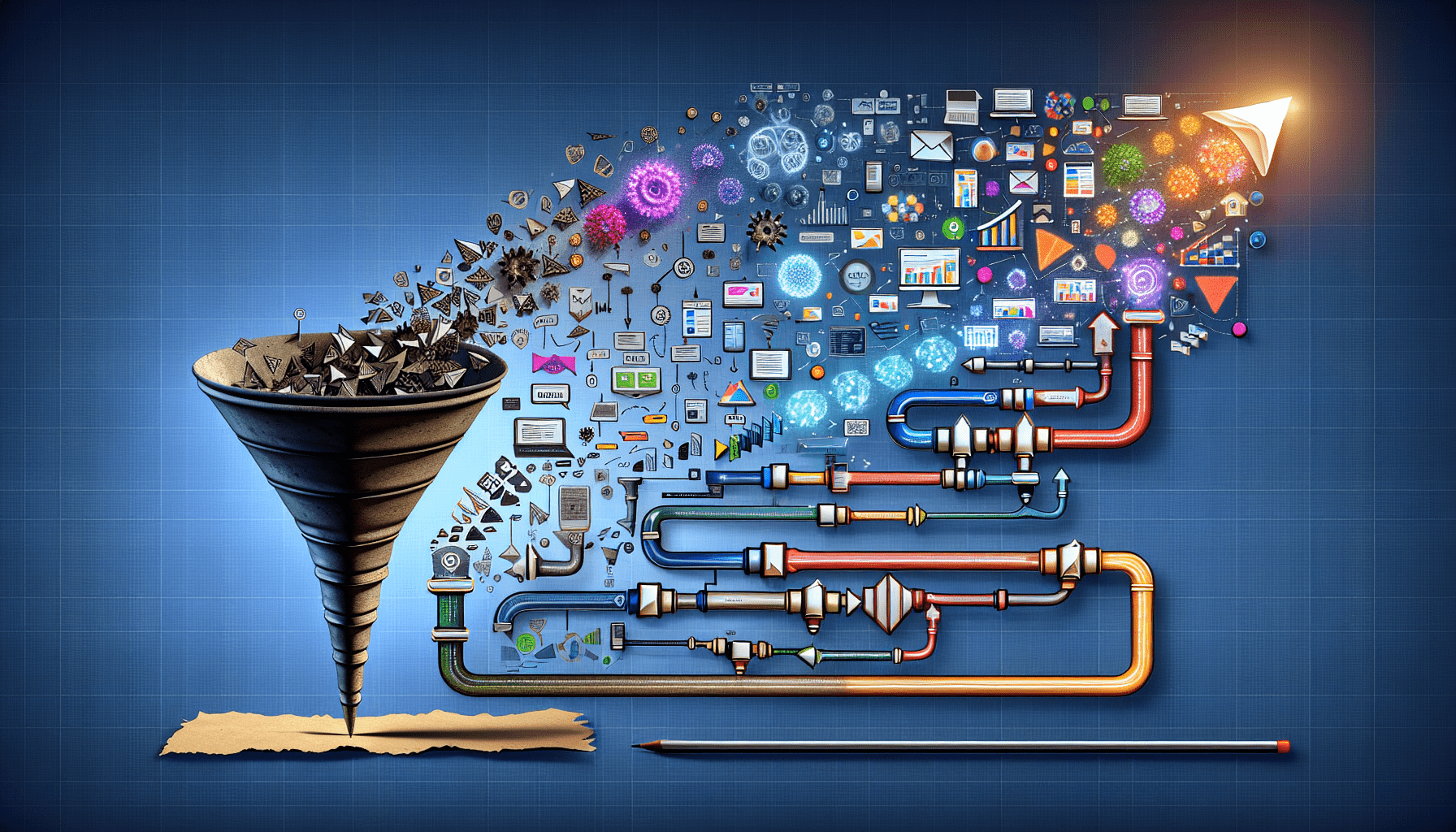Funnel building technologies have come a long way over the years, constantly evolving and adapting to meet the ever-changing needs of businesses. From the early days when building a funnel required technical expertise and coding skills, to the user-friendly drag-and-drop interfaces we have today, the evolution of these technologies has made it easier than ever for businesses to create effective sales funnels. This article takes a closer look at the advancements in funnel building technologies and how they have revolutionized the way businesses attract and convert customers.

The Early Days of Funnel Building
The Pre-Digital Era
In the pre-digital era, funnel building was a manual and time-consuming process. Marketers relied heavily on traditional marketing channels such as print, television, and radio advertisements to attract potential customers. The concept of a sales funnel was already established, but constructing a funnel required meticulous planning and execution.
Manual Funnel Building Techniques
Marketers would design physical sales funnels using tools and materials such as posters, brochures, and mailers. These funnels were created to guide potential customers through a step-by-step process from awareness to conversion. The manual construction process involved identifying target audiences, creating engaging content, and strategically placing marketing materials to capture attention and drive action.
Limitations and Challenges
The manual approach to funnel building presented several limitations and challenges. Marketers had limited control over the customer’s journey and interaction with the funnel. It was difficult to track and measure the effectiveness of each stage in the funnel. Moreover, making changes to the funnel required significant time and resources, resulting in a rigid and inflexible marketing strategy.
The Rise of Digital Funnel Building
Advancements in Technology
The rise of digital technology revolutionized the way marketers built funnels. The internet and advancements in software and hardware provided new opportunities and avenues for attracting and engaging potential customers. Digital marketing channels such as websites, search engines, social media, and email marketing became prevalent, enabling marketers to reach a wider audience and track their interactions with the funnel.
Automation and Optimization
Digital funnel building introduced automation and optimization techniques that greatly enhanced the efficiency and effectiveness of the marketing process. With the help of marketing automation tools and software, marketers could automate repetitive tasks, such as email sequences and lead nurturing, allowing them to focus on more strategic aspects of their campaigns. Additionally, digital funnels enabled real-time tracking and analysis, providing insights that helped optimize the funnel’s performance.
Wider Accessibility
Digital funnel building made marketing strategies more accessible to businesses of all sizes. The relatively low cost of implementation and the ability to target specific demographics or behaviors made it possible for small businesses to compete with larger enterprises. The democratization of marketing technology leveled the playing field, allowing businesses to reach their target audience without a hefty budget.
Funnel Building Platforms and Tools
Introduction of Online Platforms
Online platforms dedicated to funnel building emerged, offering marketers a streamlined and user-friendly way to create and manage their funnels. These platforms provided pre-designed templates, drag-and-drop functionality, and integration with various marketing tools. Marketers could now build, customize, and launch their funnels without the need for extensive technical skills or coding knowledge.
Popular Funnel Building Tools
Several popular funnel building tools gained popularity due to their ease of use and robust features. Tools like ClickFunnels, Leadpages, and Unbounce offered a range of functionality such as landing page creation, A/B testing, email automation, and CRM integration. These tools became essential for marketers looking to create optimized and high-converting funnels.
Features and Benefits
Funnel building platforms and tools offered a range of features and benefits that simplified the process of creating and managing funnels. These tools provided a seamless user experience, allowing marketers to visualize their funnels and make real-time changes. Integration with other marketing software streamlined the data flow between different platforms, providing a holistic view of the customer journey. Additionally, advanced analytics and reporting capabilities enabled marketers to track and measure the effectiveness of their funnels accurately.

Integration of Marketing Technologies
CRM Integration
Integrating customer relationship management (CRM) software with funnel building technology became a crucial aspect of modern marketing strategies. CRM integration allowed marketers to consolidate customer data and track interactions with a particular funnel across multiple touchpoints. This integration provided a unified view of the customer and assisted in lead generation, lead nurturing, and improved customer relationship management.
Email Marketing Integration
Email marketing integration became an integral part of funnel building. Connecting funnel building tools with email marketing software enabled marketers to segment and target leads, create personalized email sequences, and automate the delivery of content. This integration helped in maintaining engagement with leads throughout the funnel and nurturing them towards conversion.
Analytics Integration
Integrating analytics platforms with funnel building technology allowed marketers to gather and analyze data from various sources. This integration provided valuable insights into customer behavior, conversion rates, and funnel performance. Marketers could now make data-driven decisions and optimize their funnels based on real-time analytics, resulting in improved conversions and return on investment.
Mobile Funnel Building
Responsive Design and Mobile Optimization
With the widespread adoption of smartphones and mobile devices, mobile funnel building became essential for reaching and engaging a broader audience. Responsive design techniques ensured that funnels appeared and functioned optimally on different screen sizes and resolutions. Mobile optimization included optimizing loading speed, simplifying navigation, and ensuring a seamless user experience for mobile users.
Mobile-specific Features
Mobile funnel building introduced unique features and functionalities designed specifically for mobile users. These features included click-to-call buttons, location-based targeting, mobile notifications, and social media sharing capabilities. Mobile-specific features enhanced user engagement and facilitated smooth navigation through the funnel, increasing the chances of conversion.
Mobile App Funnel Building
The rise of mobile apps presented new opportunities for funnel building. Marketers could create dedicated mobile apps that acted as funnels, offering a personalized and immersive experience for users. Mobile app funnel building allowed for deeper engagement, push notifications, and customized user experiences, resulting in higher conversion rates and customer loyalty.
Artificial Intelligence in Funnel Building
Machine Learning and Predictive Analytics
The integration of artificial intelligence (AI) technologies in funnel building opened up new possibilities for personalization and optimization. Machine learning algorithms analyzed customer data and behavior patterns to predict future actions and deliver personalized content and recommendations. This intelligent use of data allowed marketers to tailor their funnels to individual customers, increasing the chances of conversion.
AI-powered Personalization
Artificial intelligence-powered personalization became a key component of funnel building. AI algorithms analyzed customer data to deliver highly relevant and targeted content at each stage of the funnel. Personalized experiences, such as dynamic landing pages, product recommendations, and customized email sequences, improved engagement and conversion rates.
Automated Chatbots and Customer Support
AI-powered chatbots revolutionized customer support and engagement within funnels. These virtual assistants could handle customer queries, provide real-time assistance, and guide users through the funnel. Automated chatbots enhanced user experience, reduced response times, and provided personalized recommendations, contributing to improved customer satisfaction and increased conversions.
Multi-channel Funnel Building
Expanding Funnel Presence
Multi-channel funnel building expanded the reach and impact of marketing campaigns. Marketers began incorporating various channels such as social media, search engine marketing, display advertising, and content marketing into their funnels. This approach ensured that potential customers could engage with the funnel through their preferred channels, increasing the chances of conversion.
Seamless Cross-channel Integration
Seamless cross-channel integration became a necessity for effective multi-channel funnel building. Marketers had to ensure consistent messaging, branding, and user experience across different channels. This integration was achieved through the use of marketing automation tools, CRM integration, and data synchronization, ensuring a cohesive customer journey and optimizing conversions.
Targeting and Personalization
Multi-channel funnel building allowed for advanced targeting and personalization strategies. Marketers could segment their target audience based on demographics, behaviors, and preferences and tailor their funnel content accordingly. By delivering personalized experiences across multiple channels, marketers could create engaging and relevant interactions that resonated with potential customers, increasing the likelihood of conversion.
Funnel Building for E-commerce
E-commerce-specific Funnel Building Challenges
Funnel building for e-commerce presented unique challenges due to the complexity of the buying process. E-commerce funnels typically involve multiple stages, including product discovery, evaluation, purchase, and post-purchase support. Marketers had to design funnels that addressed these stages while ensuring a seamless and personalized shopping experience.
Product Recommendation Engines
Product recommendation engines became valuable tools for e-commerce funnel building. By analyzing customer data, browsing behavior, and purchase history, these engines could suggest relevant products to potential customers. Product recommendations enhanced the shopping experience, encouraged upsells and cross-sells, and improved overall conversions and customer satisfaction.
Social Commerce Integration
Integrating social media platforms with e-commerce funnels opened up new avenues for driving sales and engagement. Social commerce integration enabled marketers to showcase products, gather user-generated content, and leverage social networks for referral marketing. By integrating social media strategies into e-commerce funnels, marketers could tap into the social influence of their target audience, increasing brand visibility and conversion rates.
Data-Driven Funnel Building
Leveraging Data for Optimization
Data-driven funnel building became a cornerstone of modern marketing strategies. Marketers could leverage customer data, behavior analytics, and conversion tracking to optimize various aspects of their funnels. By analyzing data, marketers could identify bottlenecks, optimize content and messaging, and make data-driven decisions to improve overall funnel performance.
A/B Testing and Conversion Rate Optimization
A/B testing emerged as a vital technique for optimizing funnel performance. Marketers could test different variants of their funnel elements, such as landing pages, call-to-action buttons, and email subject lines, to identify the most effective options. By implementing the winning variants, marketers could improve conversion rates and maximize the effectiveness of their funnels.
Real-time Analytics for Performance Tracking
Real-time analytics provided marketers with instant insights into funnel performance. Marketers could track key metrics such as click-through rates, conversion rates, and customer engagement in real-time, allowing for immediate adjustments and optimizations. Real-time analytics enabled marketers to react quickly to changes in customer behavior, ensuring their funnels remained effective and relevant.
Future Trends in Funnel Building
Voice and Conversational Interfaces
The increasing popularity of voice assistants and conversational interfaces is set to revolutionize funnel building. Marketers will need to adapt to voice search optimization and conversational marketing to ensure their funnels are accessible and engaging across these emerging platforms. Voice-activated funnels, interactive chatbots, and voice-based recommendations will play a significant role in future funnel building strategies.
Virtual Reality and Immersive Experiences
Virtual reality (VR) and immersive technologies hold immense potential for creating compelling and interactive funnel experiences. Marketers can leverage VR to provide virtual product demonstrations, virtual showrooms, and immersive storytelling. These immersive experiences will engage users on a deeper level, enhancing brand perception and driving conversions.
Integration with Internet of Things (IoT)
The integration of funnel building with the Internet of Things (IoT) will open up new possibilities for personalized and seamless customer experiences. IoT devices, such as smart home systems and wearables, will offer marketers new touchpoints to engage with potential customers. Marketers can leverage IoT data to deliver personalized content, automate interactions, and create innovative funnel experiences that bridge the physical and digital worlds.
As funnel building technologies continue to evolve, marketers must adapt and embrace these advancements to stay ahead of the competition. By leveraging digital platforms, integrating marketing technologies, and embracing new trends, marketers can create highly optimized and personalized funnels that drive conversions and deliver exceptional customer experiences.

